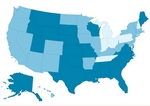business
Post-reform positioning (America's Health Insurance Plans annual meeting)
■ Insurers struggle to align marketing to individual members and physicians with cost-cutting and new technology.
By Emily Berry — Posted July 11, 2011
- WITH THIS STORY:
- » Overheard at AHIP
- » Health reform's impact so far
- » Social and physician networks
- » Related content
Like physicians, health plans are still waiting to see exactly where health reform leaves them, and in what condition. While they're waiting for health insurance exchanges and medical spending minimums to play out, they have to keep operating and planning for the future.
Some of that strategizing happened at the 2011 Institute hosted in San Francisco by trade group America's Health Insurance Plans.
Health insurance executives spent time and energy trying to prepare for a business climate that will look different in 2015 than it does today. Some of those key differences will affect physicians directly, increasing or decreasing their incomes, determining what technology ends up at their offices and how many patient visits per day it takes to pay the bills.
Some health plan executives talk about "reform" as a synonym for the Patient Protection and Affordable Care Act. But some of these trends were already in the works and will continue independently of the federal law, even if the law is repealed or thrown out of court.
"Whatever happens to health care reform, things are going to change. We need to change the way we do business," Andrea Gelzer, MD, corporate chief medical officer of AmeriHealth Mercy, a Philadelphia-based Medicaid managed care organization, said in a session at the AHIP meeting.
A few key elements of insurers' planning emerged at the meeting:
First, cutting overhead is critical. With medical spending minimums in place starting this year, health plans' profitability depends on efficiency. They are looking for ways to cut costs that do not affect medical spending. That's a reversal from decades of trying to minimize spending.
Second, individual customers are the new market, since individuals, not employers, will be doing more shopping for coverage in the future. Marketing to people who fit into thousands of niches is different from marketing to executives at large corporations. Some health plans are experienced at this but are used to spending lots of money in their individual markets. That budget will be constrained in this new era.
Third, health plans will share financial risk and use new technology with physicians in this post-reform world. Insurers want to identify which systems are going to work best and figure out how to get doctors and hospitals to practice in a way that saves everyone money.
Cutting overhead
In a time of change, the leanest-running businesses survive. Health insurers typically operate with a margin of less than 5%. Cutting overhead costs has become a top priority.
"Payers are in the same position a lot of industries have been that are under pressure from a cost standpoint," said Andy Sekel, PhD, CEO of Optum Behavioral Health Solutions. "So I think they're identifying 'What are we good at, and what are we struggling with?' and 'How do we start thinking about outsourcing what we struggle with?' "
Sekel's division is part of a new unit of UnitedHealth Group. The company merged three separate service businesses (including the entity previously known as Ingenix) under the Optum umbrella this year to offer a single source of support for payers and other health care entities.
Optum has started to offer to take over the tough parts of running a health plan for some clients, sometimes in a way that's invisible to the client's customers. That lets plans concentrate on preparing for the future, said Eric Murphy, president of Optum's Payer Solutions business.
Another way to cut overhead is to address the cost of employees it takes to process millions of claims every year. Employees are a huge expense for any business. In health insurance, they also are the source of errors and inconsistency when it comes to claims processing.
Sunny Singh is against outsourcing to save money. That's not a good answer to inefficiency, he said. Instead, his Seattle-based company, Edifecs, helps plans tackle administrative tasks that are needlessly complex.
Singh believes all the savings needed to rescue the American health care system are there for the taking, simply by addressing inefficiency.
Compared with retail businesses that spend about 2% of revenue settling bills and payment, nonmedical expenses take up 15% to 25% of every dollar spent on health care. Reducing that amount by half could pay for coverage for all of the uninsured, he said. "Our whole goal is, how can we 'retail-ize' administrative tasks and processes in modern health care?"
Selling to one customer at a time
The health insurance industry will have to "retail-ize" in more ways than one. With the introduction of state-based health insurance exchanges and growth in other individual insurance lines like Medicare Advantage, most large health plans expect to begin selling to many, if not most, customers one at a time rather than one corporation at a time.
That's a major challenge in an industry not exactly known for its customer service.
Dr. Gelzer, of AmeriHealth Mercy, addressed that challenge as part of a presentation at the AHIP meeting on re-engineering the health plan business model to succeed in a post-reform market.
"To really propel health care forward, it has to be seen as a customer-friendly commodity," Dr. Gelzer said. "It needs to be transparent. It has to be easy to use. We need to look at other industries' innovations. Other industries have made accommodations to increase consumer access and options. For example, the banking industry -- my bank no longer closes at 3 in the afternoon. It's open on Saturday until 3."
She pointed to FedEx as another good example of a business that has made it easy for customers to track something that passes through a lot of hands -- kind of like health information -- but make that information easily accessible for everyone who needs it. That's the kind of consumer focus health care must adopt, she said.
Health plans have massive amounts of data about customers. Information from credit card companies and other vendors can be used to figure out how best to market to individuals once customers have the freedom to buy coverage of their choice, said Jason Burke, managing director and chief strategist for the SAS Center for Health Analytics & Insights. SAS is a large software and data analytics firm based in Cary, N.C.
He said that by using data analytics, for example, health plans can identify which members or prospective members respond best to email, social media or telephone. That's useful to reach someone to sell coverage to or to contact a member whose behavior the plan wants to influence.
"It doesn't do you any good to send me an email if I'm not an email guy," he said. "But I might be a very heavy social media user. So knowing, for example, where I tend to interact, and understanding what kinds of interactions are best served by which channel," is useful.
Burke said health plans aren't taking advantage of the available information about their customers like other industries such as banking or telecommunications.
The key to the doctor's office
As they reach out to potential new members, health plans are sensitive to another key constituency: physicians.
Craig Keyes, MD, chief medical officer of Atlanta-based health management company Alere, began his career as an internist and then managed New York and Colorado markets for United. Alere is one of many vendors that attended the AHIP meeting hoping to convince insurers that they hold the answer to influencing physician behavior.
Health insurers have been trying for years to find a way to mine the claims data they hold and use the information to send physicians useful alerts and clinical insights that can improve quality and save money. For example, a health plan might know from claims data that a diabetic patient went to the emergency department on a Saturday night because of dangerously high blood sugar, but the patient's primary care physician might not know unless the health plan shares that information. Encouraging the primacy care physician to talk to the patient about how to manage blood sugar might improve the patient's health and save money by avoiding ED visits.
The problem is that many health plans send too many alerts or don't target what will be most useful. Most physicians don't need more piles of clinical information. Many distrust anything health insurers say, particularly when it interferes with the physician-patient relationship or appears to focus on cost rather than quality.
Dr. Keyes said health plans value the way Alere sends and shares information to physicians, because it saves them from having to shove information at doctors. "One of our jobs is to make it not only simpler, but more meaningful," he said.
Dr. Gelzer said sometimes communicating with physicians and their staffs is all about timing. For example, because Medicaid members frequently move in and out of coverage, physician offices almost always check eligibility when they care for a Medicaid enrollee.
So rather than sending clinical notes about those patients after a visit, perhaps noting a gap in care, AmeriHealth realized it made more sense to flag members in the eligibility system, prompting staff to check on what tests or preventive treatments might be needed. Physicians click on those flags 42% of the time, she said.
As physicians and health plans begin to build up accountable care organizations and other new models of care, data can flow a bit more freely, she said. A recently expanded pilot program in Pennsylvania put a case manager employed by AmeriHealth to work at a large primary care physicians' practice, working with physicians and their staff. The investment paid off, improving care, saving money for the health plan and providing useful information to physicians.
"We've talked about alignment of goals for so long, but hopefully we've reached a critical point where that's really going to happen," she said.












